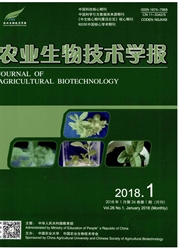

 中文摘要:
中文摘要:
小菜蛾(Plutella xylostella(Linn.))是十字花科蔬菜为害最重的害虫,对拟除虫菊酯类农药已经普遍产生了严重抗性。为完整了解小菜蛾对拟除虫菊酯类农药抗性特点,本研究采用核苷酸测序法检测了室内饲养种群及小菜蛾田间种群的击倒抗性基因频率,及氰戊菊酯处理后死亡个体的基因型组成。结果显示,本研究中仅检测到L1014F和T929I两个位点突变;室内饲养的小菜蛾2-4龄幼虫2个位点突变频率均为98.75%-100%,福建、浙江、内蒙古、北京等地小菜蛾田间种群在2个位点突变频率分别为90.00%-100%和88.75%-100%;2010-11-2011-11福州埔垱菜区田间小菜蛾2个位点突变频率相同,均为98.75%-100%;因氰戊菊酯处理死亡的个体在2个位点均为抗性纯合子。研究结果表明,小菜蛾抗性基因型较为单一;不同龄期、同一季节不同地区、同一地区不同季节小菜蛾抗性基因频率变化均较小;T929I突变在L1014F突变基础上产生,但当L1014F突变位点为杂合子时,T929I突变位点便为抗性杂合子或敏感纯合子;突变位点基因型不是小菜蛾对氰戊菊酯敏感性的唯一决定因素。本研究有助于更好了解小菜蛾对拟除虫菊酯类农药抗性的发生特点。
 英文摘要:
英文摘要:
The diamondback moth(Plutella xylostella(Linn.), DBM) is the most destructive insect pest of cruciferous vegetables throughout the world and has become highly resistant to pyrethroid insecticides. To furtherly elucidate the occurrence characteristics of knockdown resistance in DBM, by means of the nucleotide sequencing method, the knockdown resistance allele frequencies in both the laboratory and field strains were detected. Besides, the genotypes of the dead individuals after fenvalerate treatment were also determined. Only L1014 F and T929 I mutations were found. Same resistance allele frequencies of 98.75% -100% were found in the 2 mutation sites in the of 2ndto 4thinstar larvae of laboratory strain. The resistance allele frequencies for L1014 F and T929 I mutations in field strains, collected from Fujian, Zhejiang, Inner Mongolia and Beijing, were of 90.00%-100% and 88.75%-100%, respectively. And that were both of 98.75%-100% in the 2 sites in the field strain collected from vegetable fields in Pudang, Fuzhou of during November,2010 and November, 2011. The dead insects after fenvalerate treatment at different concentrations were all resistant homozygotes in 2 mutation sites. The results indicated that genotypes at the mutation sites were mainly resistant homozygous in DBM and knockdown resistance allele frequencies varied little with larval instar, occurrence seasons in the same locality and different collection localities in the same season. T929 I mutation occurred only together with L1014 F mutation, whereas, when the genotype was heterozygously resistant in L1014 F site, then that would be homozygously susceptible or heterozygously resistant in T929 I site. Genotype at mutation sites was not the sole factor that determined the sensitivity of DBM to fenvalerate.This study will help to betterly understand the evolution characteristics of knockdown resistance in DBM.
 同期刊论文项目
同期刊论文项目
 同项目期刊论文
同项目期刊论文
 期刊信息
期刊信息
